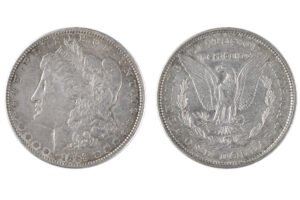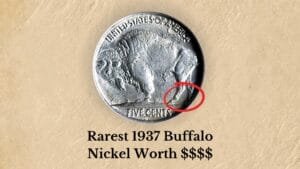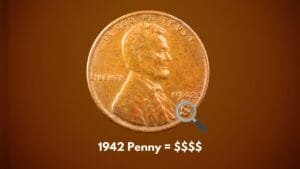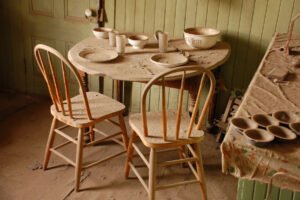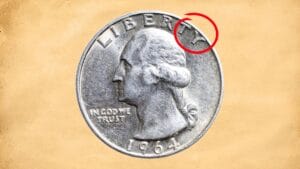The 1971 Eisenhower Dollar marked the return of the large dollar to U.S. currency, making it a significant coin in numismatic history. But many collectors overlook this coin due to its lack of popularity back then!
But did you know that a rare specimen of a 1971 dollar coin sold for a whopping $264,000 in an auction?
That’s the monetary potential of a 1971 Eisenhower Dollar. So, let’s find out if your 1971-dollar coin is worth a fortune! From mint marks to minting errors, this guide explains all the special features to identify and value a genuine 1971 Eisenhower Dollar!
An Overview of the 1971 Eisenhower Dollar History
The 1971 Eisenhower Dollar is the first coin of its series, marking the end of a seven-year hiatus in large dollar coin production following the cessation of Silver Dollars in 1964. This new coin was introduced as a tribute to President Dwight D. Eisenhower, who had passed away in 1969, and to commemorate the recent Apollo 11 moon landing.
The coin’s design was the work of U.S. Mint Chief Engraver Frank Gasparro. He based the obverse on a portrait of Eisenhower he had created for the President’s inaugural medal in 1953. The reverse, featuring an eagle landing on the moon, was inspired by the Apollo 11 mission patch designed by astronaut Michael Collins.
Despite initial enthusiasm, the Eisenhower Dollar struggled to gain widespread circulation due to its size and weight. However, it remained in production until 1978, with the 1971 issue being particularly significant as the inaugural year of the series.
| 1971 Eisenhower Dollar | Key Facts |
| Material (Composition) | Copper (75%) and Nickel (25%) over a pure Copper center |
| Minting Location | Philadelphia, Denver, San Francisco |
| Year of Minting | 1971 |
| Weight | 22.68 grams (Copper/Nickel-clad), 24.62 grams (Silver-clad) |
| Diameter | 38.1 mm |
| Thickness | 2.58 mm |
| Designer | Frank Gasparro |
| Face Value | $1 |
| Mint Marks | No Mint Mark-Philadelphia Mint, D- Denver Mint, S- San Francisco Mint |
| Total Mintage (All Facilities) | 127,520,188 coins |
Identifying a 1971 Eisenhower Dollar (Design & Composition)
You can easily identify a 1971 Eisenhower Silver Dollar by examining its distinct design elements on both the obverse and reverse and understanding its composition and physical characteristics.
1971 Eisenhower Dollar Obverse Design:
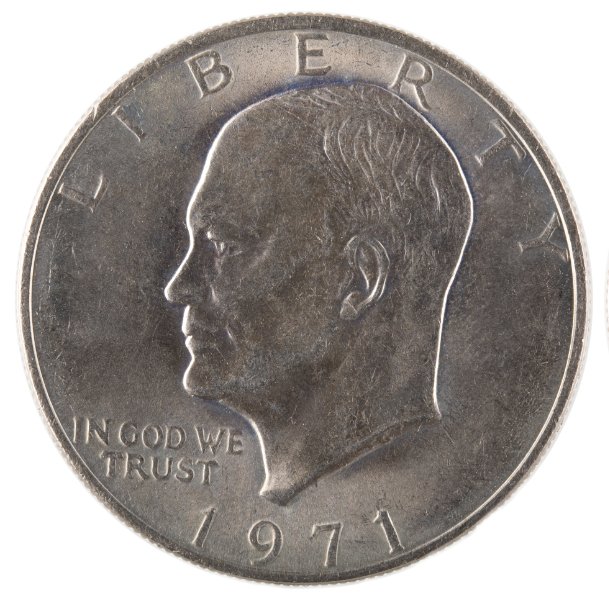
- Portrait of President Dwight D. Eisenhower facing left
- The inscription “LIBERTY” along the upper rim
- Motto “IN GOD WE TRUST” to the left of Eisenhower’s neck
- Date “1971” below the portrait
- The designer’s initials “FG” (Frank Gasparro) on the truncation of the neck
- The mint mark, if present,
1971 Eisenhower Dollar Reverse Design:

- Bald eagle landing on the moon, olive branch in talons
- Earth visible in the background
- Inscription “UNITED STATES OF AMERICA” along the upper rim
- Motto “E PLURIBUS UNUM” above the eagle
- Denomination “ONE DOLLAR” at the bottom
- Thirteen stars surrounding the eagle, representing the original colonies
Coin Composition, Size, Dimensions:
The 1971 Eisenhower Dollar was minted in two distinct compositions:
- Copper-Nickel Clad (for circulation): This version consists of an inner core of pure copper between outer layers of 75% copper and 25% nickel and weighs 22.68 grams.
- 40% Silver (for collectors): The silver dollar, only minted at the San Francisco Mint for coin collectors, contains an inner core of 79% copper and 21% silver, with outer layers of 80% silver and 20% copper. It weighs 24.59 grams.
As for the dimensions, both 1971 silver dollar versions measure 38.1 mm (1.5 inches) in diameter and have a reeded edge with a thickness of 2.58 mm. However, the copper-nickel-clad version has a distinctive copper-colored edge, while the silver coin shows a silver edge.
How to Find a 1971 Eisenhower Dollar Coin Value (4 Factors)
On average, a circulated 1971 Eisenhower Dollar is worth its face value of $1 due to its overall high mintage. However, uncirculated examples or silver versions can fetch from $5 to over $11,500, depending on factors such as mint mark, condition, and errors or varieties.
1. Coin Grading and Condition
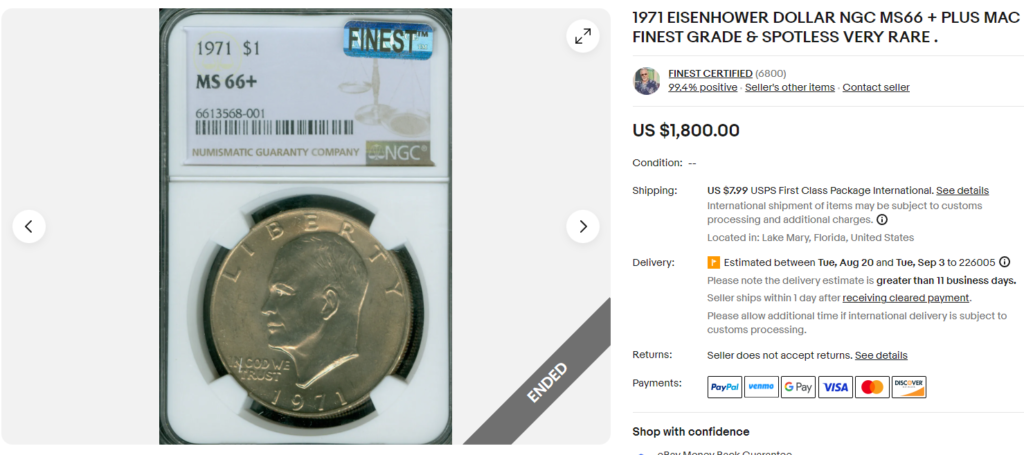
The condition of a 1971 Eisenhower Dollar significantly impacts its value. Coins are graded on a scale from Poor (P-1) to Perfect Mint State (MS-70) for circulation strikes and from Poor (PO-1) to Perfect Proof (PR-70) for proof coins.
For 1971 Eisenhower Dollars, coins in MS-67+ condition or higher tend to command premium prices of up to $5,000 to $10,000!
This following 1971 Eisenhower Dollar value chart will help you find the average worth of your coin based on condition grades.
| Coin Grades | 1971 $1 No Mint Mark | 1971-D $1 |
| Poor (0) to Extremely Fine (XF45) | A few cents to $1 | A few cents to $1 |
| Almost Uncirculated (AU50) to Mint State (MS60) | $1 to $10 | $1 to $15 |
| Mint State (MS61 – MS66) | $10 – $750 | $10 – $300 |
| Mint State (MS66+ onwards) | $1,000 – $10,500+ | $150 – $8,000+ |
2. Mint Marks & Mintage
The total mintage for 1971 Eisenhower Dollars across all mints was 127,520,188 coins. You can track the mint location by the mint mark, which, if present, is located on the coin’s obverse below the date.
The breakdown by mint and their respective values are as follows:
- 1971 Silver Dollar No Mint Mark: The Philadelphia mint produced a total of 47,799,000 dollar coins in 1971. In high-grade uncirculated condition (MS-67+), 1971 no mint mark silver dollars can be worth between $5,000 to $10,000 or more, while circulated coins are traded at face value. Common uncirculated coins are worth $10 to $50.
- 1971-D Silver Dollar: The Denver Mint produced around 68,587,424 Eisenhower dollars, which are more common than the Philadelphia-minted ones. Circulated 1971-D dollar coins are generally worth face value, while uncirculated coins can range from $3 to $30, with high-grade (MS67+) coins fetching up to $1,000 to $2,000.
3. 1971 Silver Dollar Coin (Brown Ikes & Blue Ikes)
The San Francisco Mint produced two versions of the 1971 Eisenhower Dollars for collectors: “proof silver dollars” and “uncirculated silver dollars.” They all feature the “S” mint mark on the obverse.
These silver coins, made with a 40% silver-clad composition (outer layers of 80% silver, 20% copper, and center of 79% copper, 21% silver), were sold in two different types of packages, known as “brown Ikes” and “blue Ikes.”
1971-S $1 Uncirculated Silver-clad Coins (Blue Ikes)
The San Francisco Mint struck 6,868,530 uncirculated 1971 Eisenhower dollar coins, which were sealed in pliofilm and placed inside a blue envelope. This blue packaging gives these coins their moniker, “blue Ikes.”
These special coins were produced on high-speed presses, just like the circulation strikes, but they are different from them because of their fine details, packaging, and silver-clad composition.
The 1971-S uncirculated silver dollars are more valuable than circulated strikes. Uncirculated coins are worth $10 – $50, with MS67+ or higher grade examples fetching up to $2,000 – $7,000, like this MS68 specimen that sold for $6,900 on Heritage Auctions.
1971-S Silver Dollar Proof Coins (Brown Ikes)
Apart from uncirculated silver dollar coins, the San Francisco Mint also produced 4,265,234 silver proof coins. These special coins were packaged in a plastic holder within a brown box adorned with a gold eagle seal and, hence, are known as “brown ikes.”
Unlike uncirculated 1971-S silver dollars, the silver-proof coins feature a stunning mirror-like or “proof” finish, with a polished appearance and sharp details that create a contrast between the background (field) and raised designs (devices).
Depending on the contrast with the mirror-like fields and raised devices, you can further categorize the 1971-S proof silver dollar coins as CAM and DCAM.
- Cameo Proofs (CAM): These coins have frosted devices (raised areas) contrasting against mirror-like fields. They’re typically worth 20-30% more than standard proofs, with high PR graded examples fetching $20 to $75.
- Deep Cameo (DCAM) Proofs: These proof coins have a stronger contrast between the frosted devices and mirrored fields. DCAM proofs can command a premium of 50-100% or more over standard proofs. Prices for Deep Cameo 1971 proofs can range from $50 to $200, with flawless PR70 examples commanding $600 to $1,000 or more.
In addition, there are two more varieties of 1971-S proof dollar coins based on the difference in the reverse design of the Earth in the background: Type 1 and Type 2. While the design is the same in all proof coins, the details are not!
- Type 1 Reverse: These coins feature a lower relief of the reverse. You can spot it by the highly detailed breast feathers of the eagle and clearly marked Caribbean islands on the surface of the Earth.
Type 1 1971 $1 silver coins are extremely rare. One of the few discovered coins graded PR68 DCAM fetched a stunning price of $30,550 at Legend Rare Coins Auctions.
- Type 2 Reverse: These proof coins have a higher relief than the Type 1 coins. These coins are quite common. In fact, most proof coins graded by PCGS are Type 2.
4. Valuable Mint Errors & Varieties on a 1971 Eisenhower Dollar
Like all other old coins, mint errors and varieties can also significantly increase the value of a 1971 Eisenhower Dollar. Let’s find the most valuable anomalies for 1971 Eisenhower Dollar and 1971-S Silver Dollar:
1971 Silver Dollar Error List
1971-S $1 Prototype Strike
Prototype strikes are the 1971-S silver dollar coins created to test the dies, strike quality, and overall design of the coin, such as the eagle and moon and President Dwight D. These coins help the U.S. Mint to make any necessary adjustments before full-scale production.
Although not an error, the Prototype Strike is exceptionally valuable, as only two such coins have been graded by PCGS as of the time of writing. One of these two 1971-S $1 Eisenhower Dollar Prototype, graded Specimen 67 (SP67), sold for a mind-boggling price of $264,000 while the other one sold for $102,000 on Heritage Auctions.
1971-S/S $1 Repunched Mint Mark
This error occurs when the mint mark “S” is struck twice on a 1971-S silver dollar coin. It can significantly increase the value of a regular 1971-S silver dollar. For example, an MS67-graded example sold for $8,812 on Heritage Auctions.
1971-S $1 Doubled Die Obverse, Type 1
This error is a result of a 1971 dollar coin getting struck by a misaligned or doubled die or double-struck by a regular die, creating doubled or shifted design elements on the obverse.
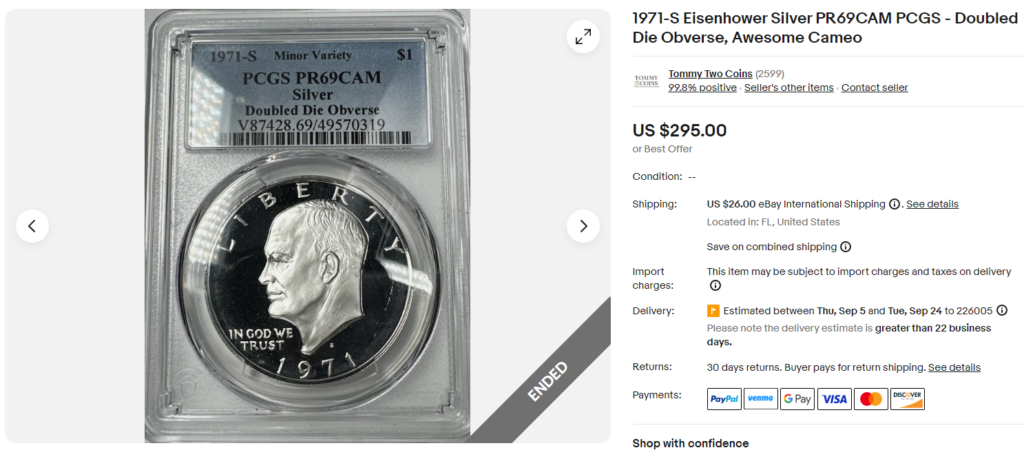
While this error is common, it becomes extremely valuable when it occurs on an already rare coin. Point in case, a rare PR68 DCAM-graded 1971-S $1 Type 1 Reverse coin with DDO error sold for about $9,400 on Heritage Auctions!
1971-S $1 Silver Peg Leg Variety
The 1971-S Peg Leg variety is a specific error found on some 1971-S Silver Eisenhower Dollars, where the leg of the letter “R” of “LIBERTY” on the obverse has a different font.
In most 1971-S $1 uncirculated silver coins, the “R” is in a serif font, which can be identified by the two protrusions on either side at the end of its vertical leg. In contrast, the letter “R” in the rare 1971-S Peg Leg variety doesn’t have the serifs (no protrusions).
Since this variety is common, its price generally ranges between $50 – $500, depending on the coin’s grade.
1971 Eisenhower Dollar Errors
Struck on a Half Dollar Planchet
This is a transitional error in which the 1971-D Eisenhower Dollar is struck on a half-dollar planchet, causing the coin’s outer edge and design to get cut out. An MS64-graded example of this error coin sold for $2,160 on Heritage Auctions.
Doubled Curved Lips
his is a clipped planchet error in which the 1971-D Eisenhower Dollar coin features two curved clips on its edge. One of these rare error coins, graded MS65, sold for $822, which is almost 15-20 times the average value of a 1971-D dollar with this grade.
Friendly Eagle Variety
As the name suggests, this 1971 Eisenhower Dollar Variety’s eagle on the reverse appears to have a slightly curved beak, making it friendlier. You can find it on the 1971 no mint mark dollar coin as well as on 1971-D dollar.
Expert Tips to Spot a Fake 1971 Eisenhower Dollar
- Verify the weight and dimensions: Use precise scales to weigh and measure the coin. Genuine 1971 dollars should weigh 22.68 grams and have a diameter of 38.1 mm. Any deviation hints at a counterfeit.
- Check the composition & weight of 1971 Silver Dollar Coins: Real 1971 silver-clad dollars have a 40% silver composition, weighing around 24.59 grams. If a coin weighs less, it’s not a silver dollar.
- Examine the edge: All 1971 dollar coins should have a reeded (grooved) edge with 150 reeds. If the edge has a crack in the reed or irregular reeding, it’s fake.
- Look for the proper mint mark location: On genuine 1971 dollar coins, the mint mark appears below Eisenhower’s neck on the obverse. A change of mint mark location indicates a fake coin.
- Use a magnet: Genuine 1971 Eisenhower Dollars (silver or clad) are not magnetic. Perform a magnet test. If your coin reacts, it’s a fake coin.
While the 1971 Eisenhower Dollar offers exciting opportunities for collectors, it’s just one of many valuable coins. Other notable issues you must look for include the 1972 Silver Dollar, 1923 Peace Silver Dollar, and 1879 Morgan Dollar! Check my detailed guides to spot and value these gems!
Note: This article is intended for informational, educational, and entertainment purposes only. Some images are illustrative and may not represent actual brands, products, or related entities. All trademarks, product names, brand logos, packaging, and other intellectual property referenced remain the exclusive property of their respective owners. Any brand mentions or references are provided solely for descriptive and educational context and do not imply any formal or commercial association.




